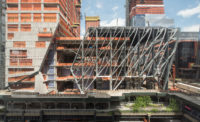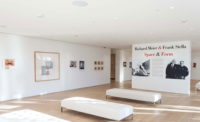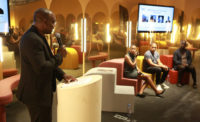Design Miami 2017: Furniture by Architects, Design by Artists, and an Early Look at the ICA

Institute of Contemporary Art, Miami
Photo by Iwan Baan

Rendering of the Mwabwindo School by Selldorf Architects
Mwabwindo, Zambia
Image courtesy Selldorf Architects

The Mwabwindo School by Selldorf Architects, under construction
Mwabwindo, Zambia
Image courtesy Selldorf Architects

The Mwabwindo School by Selldorf Architects, under construction
Mwabwindo, Zambia
Image courtesy Selldorf Architects

Christ & Gantenbein partner Emanuel Christ at Design Miami 2017 with the custom furniture his firm designed for the Mwabwindo School by Selldorf Architects
Photo © Fred A. Bernstein

Institute of Contemporary Art, Miami
Photo by Iwan Baan

Institute of Contemporary Art, Miami
Photo by Iwan Baan

Institute of Contemporary Art, Miami
Photo by Iwan Baan

Institute of Contemporary Art, Miami
Photo by Iwan Baan









“I can’t see enough pictures of people learning to make brick,” said Annabelle Selldorf, joyfully. She was describing the construction of the Mwabwindo School in Zambia, designed by her Manhattan firm (“everyone in the office wanted to participate”) and now being built by local laborers. Selldorf was honored as a “visionary” at Design Miami, along with the Basel architecture firm Christ & Gantenbein, which designed furniture for the school.

Photo © Fred A. Bernstein
Prototypes of the stools and tables, in which native hardwoods are held together without glue or nails, were on display, along with models of the Selldorf building, as part of an effort to raise $120,000, the school’s operating budget for next year. Of course, during Design Miami, part of the annual bacchanal surrounding the Art Basel fair, $120,000 is the cost of a cocktail party. But juxtapositions of the very poor and the very rich are par for the course these days, and those creating the Mwabwindo School are dedicated to the cause. “It’s small furniture for kids, but it’s big on symbolic value,” said Christ & Gantenbein partner Emanuel Christ of the butcher block–like pieces.
It was hardly the only furniture by architects at Design Miami, held in an elaborate tent near the Miami Beach Convention Center. Philippe Gravier of Paris is showing lacquered wood tables by the Japanese architect Kengo Kuma, while Maniera, a Brussels gallery, has a booth devoted to subtly seductive seating and storage by Bijoy Jain of Studio Mumbai. (Maniera also sells limited edition pieces by Christ & Gantenbein.) And, at a time when designers aspire to make art, there was a surprising amount of design by successful artists. At Salon 94 Design, artist Tom Sachs was showing his first line of furniture, much of it fabricated from plywood. (According to gallerist Paul Johnson, the pieces are called Knoll, to tweak the large furniture maker; Johnson added that the gallery has yet to receive a ‘cease and desist’ letter.) And the brothers Doug and Mike Starn created a series of pieces from strips of bamboo, lashed together with cord, for the gallerist Christina Grajales. The sofas and chairs, which arose from their “Big Bambú” series of art installations (one atop the Metropolitan Museum of Art in 2010) require thousands of lashings. A single, throne-like chair took eight people a month to make, said Mike Starn. The chair couldn’t be cozier, despite its ominous name: “All the Nightmares Came Today.”
Design Miami was founded by Craig Robins, whose other focus is the Design District on the Miami mainland. There Robins, who two years ago unveiled an arcade by Sou Fujimoto (the Japanese architect’s first U.S. project), continues to employ up-and-coming architects, including 2017 Design Vanguard firm FreelandBuck, for a pair of dining terraces, and Johnston Marklee, for another arcade. Retailers, too, hype architecture. (Oliver Peoples, the eyeglass company, described its new Design District boutique as the work of “the Milan-based design firm of the moment, Dimore Studio.”) A plaza called the Paseo Ponti now features a series of treelike sculptures in steel and glass, described as an “organic pergola,” by the brothers Ronan and Erwan Bouroullec. But the big news is the debut of the Institute of Contemporary Art (ICA), Miami, a 37,500-square foot museum in a new building by the Madrid architects Aranguren + Gallegos.
Contemporary art is often shown in converted industrial buildings—think of MASS MoCA, the Prada Foundation, the Tate Modern—which give it a kind of gravitas. By contrast, contemporary art in brand new buildings can seem flimsy. That was the challenge facing the architects, and they might well have fumbled—the building’s facade, almost an exact copy of one they did for a museum in Madrid, is a jigsaw puzzle of metal triangles; it looks more like an art installation than a permanent piece of architecture.

Photo by Iwan Baan
Luckily, the architects, who cite a small museum project by Le Corbusier as an influence, created three floors of really good galleries, with high ceilings, handsome wood floors, and round Corbusian columns. “I have the most beautiful galleries in Miami,” said the ICA’s director, Ellen Salpeter. She was including the museum’s outdoor gallery, a 15,000-square-foot, sculpture-filled backyard that is engulfed by the foliage of Buena Vista, the residential neighborhood just north of the museum. In the front, the museum is part of the cacophonous Design District; in the rear, it could be in the Miami of an earlier era, before art and design fever took over.












